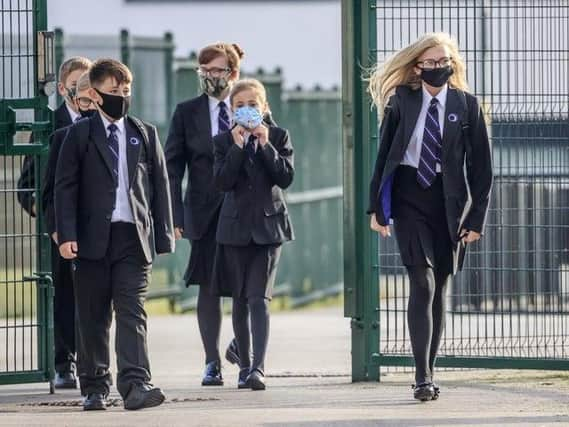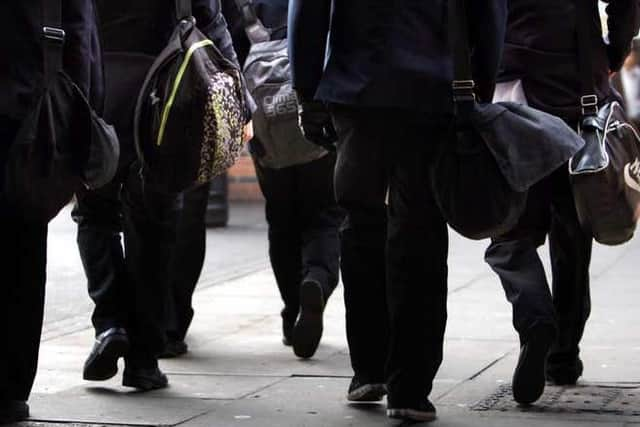Back to school in Leeds: Rules on face masks, testing, attendance, school buses and packed lunches as all primary and secondary pupils must return on Monday


From Monday, all pupils must go to school unless they or a family member or contact has developed Covid symptoms. Here are some of the key things you need to know - and how it will work:
Should kids wear face masks?
we now also recommend in those schools, that face coverings should be worn in classrooms or during activities unless social distancing can be maintained. This does not apply in situations where wearing a face covering would impact on the ability to take part in exercise or strenuous activity, for example in PE lessons. In primary schools, we recommend that face coverings should be worn by staff and adult visitors in situations where social distancing between adults is not possible (for example, when moving around in corridors and communal areas). Children in primary school should not wear face coverings


How should children get to school?
Advertisement
Hide AdAdvertisement
Hide AdPupils and staff may use public transport where necessary, but we encourage them to walk, cycle or scoot to and from school wherever it is possible and safe to do so. Where pupils and staff need to use public transport, they should follow the safer travel guidance for passengers. The transport to schools and other places of education guidance requires those involved in the provision of dedicated transport to schools to identify the risks. You should adopt measures to address those risks in a way that works in the local 19 circumstances. Distancing should be maximised and mixing of groups should be minimised where possible and practical. People aged 11 and over must wear a face covering when travelling on public transport. In accordance with advice from PHE, they must also wear a face covering when travelling on dedicated transport to secondary school. People who are exempt do not need to wear a face covering.
Does my child HAVE to go back to school?
School attendance will be mandatory for all pupils from 8 March. The usual rules on school attendance apply, including: • parents’ duty to secure their child’s regular attendance at school (where the child is a registered pupil at school and they are of compulsory school age) • the ability to issue sanctions, including fines fixed penalty notices in line with local authorities’ codes of conduct As usual, you are responsible for recording attendance, following up absence and reporting children missing education to the local authority.
During the week commencing 8 March, pupils will be offered asymptomatic testing on site in secondary schools. Pupils who consent to testing should return to face-toface education following their first negative test result. Pupils not undergoing testing should attend school in line with your phased return arrangements. Vulnerable children and children of critical workers in secondary schools should continue to attend school throughout, unless they receive a positive test result. Testing is voluntary, but strongly encouraged. You should not plan for rotas as there is no requirement to reduce occupancy in schools. Instead, everyone must follow the system of controls.
How does asyptomatic testing work at secondary schools in Leeds?
Advertisement
Hide AdAdvertisement
Hide AdSecondary schools should offer pupils testing at an on-site ATS from 8 March, government guidance says.
It states: "Testing and return of pupils can be phased during the first week to manage the number of pupils passing through the test site at any one time. You should offer 3 tests, 3 to 5 days apart. You have the flexibility to consider how best to deliver testing on a phased basis from 8 March, depending on your circumstances and local arrangements, but you should prioritise vulnerable children and children of critical workers, and year groups 10 to 13.
"Pupils should return to face-to-face education following their first negative test result. Pupils not undergoing testing should attend school in line with your phased return arrangements. Schools will have discretion on how to test students over that week as they return to the classroom. Testing is voluntary. If consent is provided, pupils will be asked to self-swab at the on-site ATS and after 30 minutes they should be informed of their results.
"Individuals with a positive LFD test result will need to self-isolate in line with the guidance for households with possible coronavirus infection. Those with a negative LFD test result can continue to attend school unless they have individually been advised otherwise by NHS Test and Trace or Public Health professionals (for example as a close contact). They should continue to apply the measures in the system of controls to themselves and the wider school setting."
Should children bring lunchboxes and stationery?
Advertisement
Hide AdAdvertisement
Hide AdPupils should limit the amount of equipment they bring into school each day, including essentials such as: • lunch boxes • hats and coats • books • stationery • mobile phones Bags are allowed. Pupils and teachers can take books and other shared resources home, although unnecessary sharing should be avoided. Similar rules on hand cleaning, cleaning of the resources and rotation should apply to these resources.
What should you do if your child has symptoms?
Staff members, parents and carers will need to: • book a test if they or their child has symptoms - the main symptoms are: a high temperature; a new continuous cough; a loss or change to your sense of smell or taste
• self-isolate immediately and not come to school if: they develop symptoms; they have been in close contact with someone who tests positive for coronavirus (COVID-19); anyone in their household or support or childcare bubble develops symptoms of coronavirus (COVID-19); they are required to do so having recently travelled from certain other countries; they have been advised to isolate by NHS test and trace or the PHE local health protection team, which is a legal obligation 24
• provide details of anyone they have been in close contact with, if they test positive for coronavirus (COVID-19) or if asked by NHS Test and Trace
Advertisement
Hide AdAdvertisement
Hide AdDoes your child need a negative Covid test before going back to school?
No: The pupil or staff member who tested positive for coronavirus (COVID-19) can return to their normal routine and stop self-isolating after they have finished their isolation period and their symptoms have gone or if they continue to have only a residual cough or anosmia. This is because a cough or anosmia can last for several weeks once the infection has gone. If they still have a high temperature after 10 days or are otherwise unwell, you should advise them to stay at home and seek medical advice.
Advice to teachers says: "You should not request evidence of negative test results or other medical evidence before admitting pupils or welcoming them back after a period of self-isolation. "In the vast majority of cases, parents and carers will be in agreement that a pupil with symptoms should not attend the school, given the potential risk to others. In the event that a parent or carer insists on a pupil attending your school, you can take the decision to refuse the pupil if, in your reasonable judgement, it is necessary to protect your pupils and staff from possible infection with coronavirus (COVID-19). Your decision would need to be carefully considered in the light of all the circumstances and current public health advice."
How school buses work
Dedicated school transport, including statutory provision: Pupils on dedicated school services do not mix with the general public on those journeys.
Advertisement
Hide AdAdvertisement
Hide Ad"This helps limit the number of other people with whom they come into contact. Local authorities are not required to uniformly apply the social distancing guidelines which are in place for public transport on dedicated school transport. However, social distancing should be put in place within vehicles wherever possible.
"Dedicated school services can take different forms and may include: • coaches regularly picking up the same pupils each day • minibuses • services which are used by different pupils on different days • services for pupils with SEND The precise approach taken will need to reflect the range of measures that are reasonable in the different circumstances. Do speak to the local authority or transport provider so that you understand the approach they are adopting. You might wish to request a copy of their updated risk assessment. It is important, wherever it is possible, that: • social distancing is maximised within vehicles • pupils either sit with their ‘bubble’ on school transport, or with the same constant group of children each day • pupils clean their hands before boarding transport and again on disembarking • additional cleaning of vehicles is put in place • organised queuing and boarding is put in place • fresh air (from outside the vehicle) through ventilation, is maximised, particularly through opening windows and ceiling vents Pupils should not board home to school transport if they, or a member of their household, has had a positive test result or has symptoms of coronavirus.